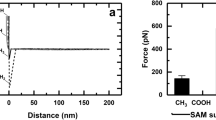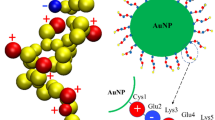Abstract
Atomistic molecular dynamics simulations are performed to investigate the influence of rutile with nanoscale surface curvature on the adsorption of fibronectin (FN-III10). To obtain the preferred adsorption orientation of FN-III10, the adsorption processes of 12 different initial orientations of FN-III10 on rutile with ideal surface are firstly simulated, and results show that only two stable orientations are obtained during the simulations. Afterward, these two preferred orientations are placed on rutile with different nanoscale curved surfaces, and simulations find that the curved surface has a significant influence on the orientation of the adsorbed FN-III10. The “side-on” orientation prefers the convex surface, while the “head-on” orientation prefers the concave surface. Further investigation on the impact mechanism shows that the dipole of the rutile caused by the defective surface has strong interaction with the dipole of the adsorbed FN-III10, which is the dominant driving force of the conformational change during the simulation. The simulation results further verify the influence of nanoscale surface of biomaterial on the adsorbed protein and highlight the possibility of surface design for advanced biomaterial development.








Similar content being viewed by others
References
Silva-Bermudez P, Rodil SE (2013) An overview of protein adsorption on metal oxide coatings for biomedical implants. Surf Coat Tech 233:147–158
Wilson CJ, Clegg RE, Leavesley DI, Pearcy MJ (2005) Mediation of biomaterial–cell interactions by adsorbed proteins: a review. Tissue Eng 11:1–18
Liao C, Xie Y, Zhou J (2014) Computer simulations of fibronectin adsorption on hydroxyapatite surfaces. RSC Adv 4:15759–15769
Liu L, Qin C, Butler WT, Ratner BD, Jiang S (2007) Controlling the orientation of bone osteopontin via its specific binding with collagen I to modulate osteoblast adhesion. J Biomed Mater Res A 80:102–110
Zhou J, Chen S, Jiang S (2003) Orientation of adsorbed antibodies on charged surfaces by computer simulation based on a united-residue model. Langmuir 19:3472–3478
Wu C, Chen M, Xing C (2010) Molecular understanding of conformational dynamics of a fibronectin module on rutile (110) surface. Langmuir 26:15972–15981
Dong XL, Zhou HL, Wu T, Wang Q (2008) Behavior regulation of adsorbed proteins via hydroxyapatite surface texture control. J Phys Chem B 112:4751–4759
Raffaini G, Ganazzoli F (2012) Molecular modelling of protein adsorption on the surface of titanium dioxide polymorphs. Philos Trans R Soc A 370:1444–1462
Panos M, Sen TZ, Ahunbay MG (2012) Molecular simulation of fibronectin adsorption onto polyurethane surfaces. Langmuir 28:12619–12628
Yang C, Peng C, Zhao D, Liao C, Zhou J, Lu X (2014) Molecular simulations of myoglobin adsorbed on rutile (1 1 0) and (0 0 1) surfaces. Fluid Phase Equilib 362:349–354
Wang K, Leng Y, Lu X, Ren F (2014) Molecular dynamics simulation of protein effects on interfacial energy between HA surfaces and solutions. Mater Lett 123:191–194
Carravetta V, Monti S (2006) Peptide-TiO2 surface interaction in solution by ab initio and molecular dynamics simulations. J Phys Chem B 110:6160–6169
Mücksch C, Urbassek HM (2011) Molecular dynamics simulation of free and forced BSA adsorption on a hydrophobic graphite surface. Langmuir 27:12938–12943
Zhang L, Sun Y (2010) Molecular simulation of adsorption and its implications to protein chromatography: a review. Biochem Eng J 48:408–415
Szott LM, Horbett TA (2011) Protein interactions with surfaces: computational approaches and repellency. Curr Opin Chem Biol 15:683–689
Rabe M, Verdes D, Seeger S (2011) Understanding protein adsorption phenomena at solid surfaces. Adv Colloid Interfac 162:87–106
Roach P, Farrar D, Perry CC (2005) Interpretation of protein adsorption: surface-induced conformational changes. J Am Chem Soc 127:6168–8173
Roach P, Eglin D, Rohde K, Perry CC (2007) Modern biomaterials: a review—bulk properties and implications of surface modifications. J Mater Sci Mater Med 18:1263–1277
Poncin-Epaillard F, Vrlinic T, Debarnot D, Mozetic M, Coudreuse A, Legeay G, El Moualij B, Zorzi W (2012) Surface treatment of polymeric materials controlling the adhesion of biomolecules. J Funct Biomater 3:528–543
Anselme K, Ploux L, Ponche A (2010) Cell/material interfaces: influence of surface chemistry and surface topography on cell adhesion. J Adhes Sci Technol 24:831–852
Gonzale-Garcia C, Sousa SR, Moratal D, Rico P, Salmeron-Sanchez M (2010) Effect of nanoscale topography on fibronectin adsorption, focal adhesion size and matrix organisation. Colloid Surface B 77:181–190
Lord MS, Foss M, Besenbacher F (2010) Influence of nanoscale surface topography on protein adsorption and cellular response. Nano Today 5:66–78
Song D, Chen M, Liang Y, Bai Q, Chen J, Zheng X (2010) Adsorption of tripeptide RGD on rutile TiO2 nanotopography surface in aqueous solution. Acta Biomater 6:684–694
Jiang X, Shang L, Wang Y, Dong S (2005) Cytochrome c superstructure biocomposite nucleated by gold nanoparticle: thermal stability and voltammetric behavior. Biomacromol 6:3030–3036
Lundqvist M, Sethson I, Jonsson B-H (2004) Protein adsorption onto silica nanoparticles: conformational changes depend on the particles’ curvature and the protein stability. Langmuir 20:10639–10647
Gu Z, Yang Z, Chong Y, Ge C, Weber JK, Bell DR, Zhou R (2015) Surface curvature relation to protein adsorption for carbon-based nanomaterials. Sci Rep 5:10886
Vertegel AA, Siegel RW, Dordick JS (2004) Silica nanoparticle size influences the structure and enzymatic activity of adsorbed lysozyme. Langmuir 20:6800–6807
Roach P, Farrar D, Perry CC (2006) Surface tailoring for controlled protein adsorption: effect of topography at the nanometer scale and chemistry. J Am Chem Soc 128:3939–3945
Raffaini G, Ganazzoli F (2013) Surface topography effects in protein adsorption on nanostructured carbon allotropes. Langmuir 29:4883–4893
Livi KJT, Schaffer B, Azzolini D, Seabourne CR, Hardcastle TP, Scott AJ, Hazen RM, Erlebacher JD, Brydson R, Sverjensky DA (2013) Atomic-scale surface roughness of rutile and implications for organic molecule adsorption. Langmuir 29:6876–6883
Melis C, Mattoni A, Colombo L (2010) Atomistic investigation of poly(3-hexylthiophene) adhesion on nanostructured titania. J Phys Chem C 114:3401–3406
Berman HM, Westbrook J, Feng Z, Gilliland G, Bhat TN, Weissig H, Shindyalov IN, Bourne PE (2000) The protein data bank. Nucl Acids Res 28:235–242
Jorgensen WL (1981) Quantum and statistical mechanical studies of liquids. 10. Transferable intermolecular potential functions for water, alcohols, and ethers application to liquid water. J Am Chem Soc 103:335–350
Pronk S, Páll S, Schulz R, Larsson P, Bjelkmar P, Apostolov R, Shirts MR, Smith JC, Kasson PM, Dvd Spoel, Hess B, Lindahl E (2013) GROMACS 4.5: a high-throughput and highly parallel open source molecular simulation toolkit. Bioinformatics 29:845–854
Bostick D, Berkowitz ML (2003) The implementation of slab geometry for membrane-channel molecular dynamics simulations. Biophys J 85:97–107
Duan Y, Wu C, Chowdhury S, Lee MC, Xiong G, Zhang W, Yang R, Cieplak P, Luo R, Lee T, Caldwell J, Wang J, Kollman P (2003) A point-charge force field for molecular mechanics simulations of proteins based on condensed-phase quantum mechanical calculations. J Comput Chem 24:1999–2012
Schneider J, Ciacchi LC (2011) A classical potential to model the adsorption of biological molecules on oxidized titanium surfaces. J Chem Theory Comput 7:473–484
Acknowledgements
The authors gratefully acknowledge financial support for this work from the National Natural Science Funds of China (Nos. 11202049 and 11432003), the National High Technology Research and Development Program of China (No. 2015AA033803), the 111 Project (B14013), the Fundamental Research Funds for the Key Laboratory of Liaoning (LZ2015016) and the Fundamental Research Funds for the Central Universities (DUT17LK08).
Author information
Authors and Affiliations
Corresponding author
Ethics declarations
Conflict of interest
The authors declare that they have no conflict of interest.
Electronic supplementary material
Below is the link to the electronic supplementary material.
Rights and permissions
About this article
Cite this article
Wang, X., Li, Z., Li, H. et al. Influence of nanoscale surface curvature of rutile on fibronectin adsorption by atomistic simulations. J Mater Sci 52, 13512–13521 (2017). https://doi.org/10.1007/s10853-017-1458-y
Received:
Accepted:
Published:
Issue Date:
DOI: https://doi.org/10.1007/s10853-017-1458-y




